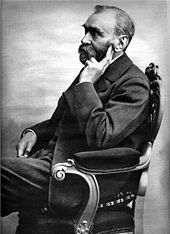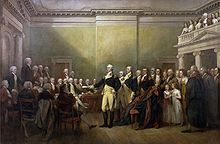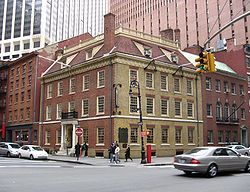On this day in 1947,A Streetcar Named Desire opened on Broadway.
 Marlon Brando‘s famous cry of “STELLA!” first booms across a Broadway stage, electrifying the audience at the Ethel Barrymore Theatre during the first-ever performance of Tennessee Williams‘ play A Streetcar Named Desire.
Marlon Brando‘s famous cry of “STELLA!” first booms across a Broadway stage, electrifying the audience at the Ethel Barrymore Theatre during the first-ever performance of Tennessee Williams‘ play A Streetcar Named Desire.
The 23-year-old Brando played the rough, working-class Polish-American Stanley Kowalski, whose violent clash with Blanche DuBois (played on Broadway by Jessica Tandy), a Southern belle with a dark past, is at the center of Williams’ famous drama. Blanche comes to stay with her sister Stella (Kim Hunter), Stanley’s wife, at their home in the French Quarter of New Orleans; she and Stanley immediately despise each other. In the climactic scene, Stanley rapes Blanche, causing her to lose her fragile grip on sanity; the play ends with her being led away in a straitjacket.
Widely considered a landmark play, A Streetcar Named Desire deals with a culture clash between two iconic characters, Blanche DuBois, a fading relic of the Old South, and Stanley Kowalski, a rising member of the industrial, urban working class.
The play presents Blanche DuBois, a fading but still-attractive Southern belle whose pretensions to virtue and culture only thinly mask alcoholism and delusions of grandeur. Her poise is an illusion she presents to shield others (but most of all, herself) from her reality, and an attempt to make herself still attractive to new male suitors. Blanche arrives at the apartment of her sister Stella Kowalski in the French Quarter of New Orleans, on Elysian Fields Avenue; the local transportation she takes to arrive there includes a streetcar route named “Desire.” The steamy, urban ambiance is a shock to Blanche’s nerves. Blanche is welcomed with some trepidation by Stella, who fears the reaction of her husband Stanley. As Blanche explains that their ancestral southern plantation, Belle Reve in Laurel, Mississippi, has been “lost” due to the “epic fornications” of their ancestors, her veneer of self-possession begins to slip drastically. Here “epic fornications” may be interpreted as the debauchery of her ancestors which in turn caused them financial losses. Blanche tells Stella that her supervisor allowed her to take time off from her job as an English teacher because of her upset nerves, when in fact, she has been fired for having an affair with a 17-year-old student. This turns out not to be the only seduction she has engaged in-and, along with other problems, has led her to escape Laurel. A brief marriage marred by the discovery that her spouse, Allan Grey, was having a homosexual affair and his subsequent suicide has led Blanche to withdraw into a world in which fantasies and illusions blend seamlessly with reality.
In contrast to both the self-effacing and deferential Stella and the pretentious refinement of Blanche, Stella’s husband, Stanley Kowalski, is a force of nature: primal, rough-hewn, brutish and sensual. He dominates Stella in every way and is physically and emotionally abusive. Stella tolerates his primal behaviour as this is part of what attracted her in the first place; their love and relationship are heavily based on powerful-even animalistic-sexual chemistry, something that Blanche finds impossible to understand.
The arrival of Blanche upsets her sister and brother-in-law’s system of mutual dependence. Stella’s concern for her sister’s well-being emboldens Blanche to hold court in the Kowalski apartment, infuriating Stanley and leading to conflict in his relationship with his wife. Blanche and Stanley are on a collision course, and Stanley’s friend and Blanche’s would-be suitor Mitch, will get trampled in their path. Stanley discovers Blanche’s past through a co-worker who travels to Laurel frequently, and he confronts her with the things she has been trying to put behind her, partly out of concern that her character flaws may be damaging to the lives of those in her new home, just as they were in Laurel, and partly out of a distaste for pretense in general. However, his attempts to “unmask” her are predictably cruel and violent. In their final confrontation, Stanley rapes Blanche, which results in her nervous breakdown. Stanley has her committed to a mental institution, and in the closing moments, Blanche utters her signature line to the kindly doctor who leads her away: “Whoever you are, I have always depended on the kindness of strangers.”
On this day in 1787, Pennsylvania becomes the second state to ratify the Constitution, by a vote of 46 to 23. Pennsylvania was the first large state to ratify, as well as the first state to endure a serious Anti-Federalist challenge to ratification.

 On this day in 1946,
On this day in 1946,  In 1953,
In 1953,  On this day in 1901,
On this day in 1901, 
 The Joint Committee on the Conduct of the War was a
The Joint Committee on the Conduct of the War was a  John and I are in our Dakota kitchen in the middle of the night. Three cats – Sasha, Micha and Charo – are looking up at John, who is making tea for us two.
John and I are in our Dakota kitchen in the middle of the night. Three cats – Sasha, Micha and Charo – are looking up at John, who is making tea for us two.





 Marlon Brando‘s famous cry of “STELLA!” first booms across a Broadway stage, electrifying the audience at the Ethel Barrymore Theatre during the first-ever performance of Tennessee Williams‘ play A Streetcar Named Desire.
Marlon Brando‘s famous cry of “STELLA!” first booms across a Broadway stage, electrifying the audience at the Ethel Barrymore Theatre during the first-ever performance of Tennessee Williams‘ play A Streetcar Named Desire.
Recent Comments